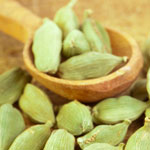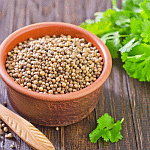.jpg)
Welcome your Winter wonder-health with Rasayanas
09.01.2017 | ADVERTORIAL | Die Wintersaison begrüßt uns mit den Feiertagen und Frohsinn, aber auch mit Schnupfen, Grippe, Gliederschmerzen und Stress. Es ist eine intensive Zeit und das Wetter mit seinen Temperaturschwankungen macht sie noch extremer. Vaidya Mishra erläutert wie Rasayanas und im Speziellen Chyawanprash da helfen. Artikel in Englisch.
The holiday season ushers in welcome mirth and celebrations, but never without sniffles, body aches, stress, and mood swings! We want to enjoy, but we get caught up overdoing it: planning, organizing, cooking, shopping. It also gets to be emotionally stressful when we miss loved ones who can’t be with us. It’s an intense time of year for sure.
And cold weather makes it more tough on our bodies – drastic drops in temperature induce doshic imbalances: our channels shrink, blocking and slowing the circulation of agni, throwing off pitta dosha, resulting in – you guessed it – uncontrollable sweet cravings. High pitta automatically increases Vata dosha so we then crave salty and sour snacks! This further aggravates our pitta and we reach out for more sweets. And all this time, Kapha is silently but surely working at keeping things under control, but getting accumulated itself and causing more clogging. By end of October, early November, the seasonal imbalance loop is already in place and it is only a matter of some Thanksgiving dinner overload and the added shopping frenzy before you wake up with sniffles, a sore throat, and achy body! Then you remember how you have absolutely no time to rest off your cold, and you further aggravate your cold with added stress – when it rains it pours!
But it does not have to be so. Let’s call the ayurvedic shastras to the rescue!
The ancient rishis knew that seasonal changes willy-nilly throw off our bodily balance. So they offered us plenty of remedies and insights. But none greater than the best kept secret: consuming rejuvenating substances – Rasayanas. Rasayanas are the essence of ayurvedic herbal synergies, prepared and charged with the power to rejuvenate, prevent disease, as well as promote longevity.
The Charaka Samhita – the ancient classical compendium of Ayurveda – defines Rasayana as ‘that which promotes strength and immunity against diseases.’ These are individual herbs and complex formulas that help us retain youthful vigor up to a good old age and which serve to make us invulnerable to disease and decay. Dying from a diseased body before reaching a ripe old age is the sign of this age of darkness – Kaliyuga. Or living into a ripe old age in a diseased body. It is not meant to be so. The body is meant to be dropped after normal wear and tear. True: things slow down, and may get rusty, but they are not meant to be broken and unusable. And death is to come naturally, at one’s will, when one’s work is done and completed. This is how it is meant to be and it used to be. Long long very long ago. But since time changes everything, and the golden age is yet to come, the sages gave us recommendations of rasayanas, to rejuvenate and maintain the body’s vigor till its last breath. So we can get very very close to that ideal state of total perfect health.
Two Types of Rasayanas
There are two types of Rasayanas: those that are preventive and promote longevity, memory and intelligence; and those that are specifically curative and are used to treat disease. Overall, Rasayanas create ojas in the body. Ojas is the most refined bi-product of digestion and metabolism. In my SVA lineage, we understand ojas to be the connecting factor between every organ and system, connecting the inner physiology and the outer world. The more ojas your digestion produces, the greater your immunity; the greater your bala – physical, mental, emotional, and spiritual stamina; and the greater your resistance and immunity to disease. Rasayanas can be taken any time of year; but the gift of winter is that it actually makes the body better able to digest, absorb, and assimilate Rasayanas.
Any rejuvenating herb or herbal formula we ingest must go through many stages of transformation to yield benefits. In Ayurvedic terms this means the better the digestion the better the transformation of a Rasayana into ojas. Winter supports transformation of Rasayanas at the macro and micro levels because our agni, or metabolic digestive fire, is generally stronger during this time of year. In winter, the surface srotas, or physical channels, shrink and the digestive fires ‘dive’ or reside more inward. This is why we tend to be hungrier and have a larger appetite in winter. We naturally crave more and heavier foods, replacing those lighter summer salads with more soups, protein, unctuous foods, and sweets.
So a rasayana is the way to go in the wintertime. But not just any. I particularly recommend one kind.
Chyawanprash & Wild Amla
Anyone even remotely familiar with Ayurvedic Rasayanas has heard about Chyawanprash and its principal ingredient, Amla. Because of the power of these Rasayanas and because winter will help you maximize their benefits, let’s see what makes them so special.
Chyawanprash; 52 Herbs for Daily Detox and Rejuvenation
When I was a child…
“The sweet taste and rich aroma of home-made chyawanprash infuses my early childhood memories spent in the village of Vaidyachak, in Jharkand, North East India. My father used to prepare Chyawanprash for our family, as well as his patients, from scratch. I used to watch him select the herbs, prep them and finally cook them.
Years later, when I studied Ayurveda formally and learnt of the countless benefits of all the herbs that go into the Chyawanprash formula, I had the desire to share it with all my ayurvedic patients, especially after moving to the West. That’s how, several years ago, I initiated the process of sourcing and gathering the best quality wild-crafted herbs that would go into the preparation. I wanted to make sure that I incorporated every single ingredient that was mentioned in the original formula without compromise of quality. Two years ago, I made my first batch of this formula according to the authentic recipe. It smelled and tasted just as good as I remembered!”
Chyawanprash is Ayurveda’s gift to us. It brings together the best of all the ‘divyaushadhi,’ or divine herbs, in a recipe that is not only balancing, but is a delicious addition to daily diet. It’s no accident that it is considered India’s national tonic!
The preparation of these 52 herbs and plants involves seven stages and is complex because the herbs that are used have different properties that need to be prepared in distinct separate steps before being combined in order to get the full benefit. The original creators of this formula, the Ashwin Gods, taught the way of infusing the different groups of herbs together based on how they can be categorized property-wise. These herbs can be grouped into three:
• Rasayana or rejuvenative herbs
• Detoxifying and cleansing herbs
• Immuno-modulatory herbs
Deriving the lipid and water soluble fractions of these herbs into a base of the Wild Amla Berry paste is a challenging process that goes through different time and temperature sensitive steps. When done properly, when the powerful molecules have been duly prepared and mixed with organic sugar and raw honey, the formulation is fully potent and active, benefiting the body as soon as it interacts with the oral mucosa. Once in the stomach, it detoxifies, traveling through the gaps of the tissues and nourishing all the aspects of the physiology.
Chyawanprash is a daily tonic good for all age groups – age 5 and above. The original formula contains ghee, cane sugar, and raw honey. The addition of ghee, honey, and sugar act as yogavahi (catalyst) to deliver the herbs to the deeper tissues. They are added as balancing ingredients because the original formula is very potent with its concentrated content of herbs and amla. They are not flavoring agents. And since they are consumed in conjunction with the dozens of herbs that are in the formula, the body is able to process and metabolize them fully. You will not make ama from the ghee, the sugar, or the honey – no one should experience discomfort or imbalance from the sugar and fat content. However, if you have fat and sugar sensitivities or prefer to avoid consuming either or both, I have put together Chyawanprash Syrup that contains no added fat (ghee) and no added sugar (honey or raw cane sugar). For those who have concerns consuming fat and/or sugar, this will be the ideal way to get the rejuvenative benefit of all the rasayana and other herbs that are part of the original formula.
The Rishis said it best: The Charak Samhita Sutra-s about Chyawanprash
Chyawanprash is a great tonic for the lungs, chronic cough, and helps alleviate breathing trouble. It supports and helps older physiologies and it nourishes the growth of children and young adults.
Chyawanprash supports the vocal chords; nurtures all seven tissues; nourishes the heart; pacifies vata; nourishes the blood; takes care of excessive thirst. It helps the urinary tract; nourishes the reproductive fluid, and pacifies the aggravated dosha-s in the urinary tract.
Increases intelligence; boosts memory; enhances glow and complexion of the skin; keeps the body disease-free; lengthens the life-span; strengthens all five senses. Chyawanprash supports and promotes conjugal bliss, strengthening both male and female physiologies! It also supports the metabolic fires; increases overall radiance; pacifies apana vata.
Summary: Chyawanprash can be used for kayakalpa protocol. Kayakalpa means ‘restoring youth to the body inside and out’! There are two kinds of kayakalp. One is called ‘Kuti praveshik,’ which is done indoors under supervision. The other is ‘vaat tapik’ or outdoors. This verse says that whoever uses Chyawanprash for the reversal of aging will get all the benefits of kayakalpa: removal of old age, rejuvenation, reclaiming beauty, strength, youthful skin, etc.
Consumer Beware!
Beware of using chyawanprash available on the market today. Many of the ingredients in the original classical formula are very hard to procure. The cost of gathering genuine ingredients is also increasing. As a result, many commercial chyawanprash brands compete against each other with lower prices. It makes me wonder how they can put together a pure and original chyawanprash formula but sell it at extremely low prices. In addition, amla berry is not even used in the proper form: nobody makes chyawanprash with wild harvested amla. Commercial companies may even be selecting genetically modified amla because wild amla has less yield. Another problem with commercial chyawanprash nowadays is the use of refined white sugar crystals, as well as ghee derived from milk butter instead of yogurt butter. Last but not least, almost all brands of commercial chyawanprash are packaged in plastic jars. Amla, its primary ingredient, being acidic in nature, will interact with the container leaching plastic molecules into the ‘prash’ or mixture making it highly toxic. In addition, herbal companies use preservatives to extend the shelf life. The original formula, when made right, has what it takes to preserve itself.
The Amazing Amla Berry and its Top 25 Benefits!
The Amla Berry (Amalaki) is the number one ingredient in Chyawanprash. But Amla is a powerful Rasayana on its own as well! This statement doesn’t take anything away from Chyawanprash – the blended paste of Wild Amla and synergistic herbs. In fact, Chyawanprash gets the nod in winter, because it’s mildly warming and contains many thermogenic herbs which further support metabolism and absorption. Being thermogenic it helps prevent ‘freezing’ of the micro channels. This is particularly important if you live in a very cold region. Due to this, when spring finally arrives, the micro channels can open more easily to release any accumulated toxins.
But if you want to take only Wild Amla Tablets, Wild Amla Herbal Memory Nectar, or Maha Wild Amla Tablets, I can give you 25 reasons why you should and in all seasons. Winter, however, affords your physiology that extra agni quotient to better transform this Rasayana into ojas and support your body’s transformation of dense protein typically eaten at this time of year.
Below you will find to the top 25 benefits of Amla. Want to know more? Read my blog article: ‘The One and Only Superfood You will Ever Need.’
1. Protein synthesis: Amla is the confirmed number one food for enhancing protein synthesis. It nourishes and maintains the muscle tissue and tones it by enhancing the absorption and digestion of protein molecules. Protein molecules, we should understand, don’t just make muscles and other tissues. Protein support the deepest parts of the physiology including our immune system and DNA & RNA. The most refined level of protein synthesis transforms these molecules into ojas – very specific protein molecules nourishing the intelligence of the physiology. These micro-molecules act like ojas. The Shastras say ojas is the connecting and communicating factor between different organs and systems. When proteins become extremely micro in nature they form the basis for ojas (hormones and neurotransmitters) – the most intelligent aspect of the physiology. For example, protein synthesis makes a hormone called Adiponectin, which governs the interaction between insulin and sugar. Furthermore, protein synthesis makes several types of immunoglobulin (antibodies) that circulate in your blood to attack viruses, bacteria, or other foreign substances. Even though you eat good sources of intelligent protein (homemade cheese, organic chicken, and lentils, etc.) you still must have optimum digestion to fully utilize them to make muscles and especially intelligent digestion to convert them to ojas. Otherwise, even the good proteins can become free radicals and induce inflammation anywhere in the body. Amla berry is the best of foods to enhance your protein synthesis and produce more ojas.
2. Vitamin C Super-source: Amla is a super-source of Vit C. It contains a particular molecule of Vit C that does not decompose in heat. Most forms of Vit C are heat sensitive and become damaged in hot areas of the body like the acidic environment of the stomach. Amla’s Vit C molecules are bound with heat-resistant tannins. They do not decompose under heat like regular ascorbic acid. Amla does not create acidity in the body, but alkalizes the body by its sweet post-digestive effect or prabhava. Scientific studies have show it to have 60 times the regular content of Vit C than citrus fruits.
3. No Malas – toxins: another name for the Amla berry, ‘a-mala-ki,’ means no mala or toxins. Amla supports the digestive system so well, strengthening pachaka agni so well, that the body makes less or zero ama or toxic build-up ‒ the number one cause for disease. As a result of proper digestion and assimilation, amla facilitates optimal elimination as well.
4. Vyastha: Amla is said to bestow everlasting youth because it is balancing to all body types, and highly alkalizing.
5. Skin Beauty and Health: Amla is the best nurturing fruit for the skin. Highly nourishing for rasa dhatu, the first layer of the skin, and rakta or blood which is the second layer. Healthy first and second tissues give the skin its glow. No malas or toxins stand a chance of accumulating in and affecting the skin, giving it all kinds of associated problems of discoloration, sagging, pudginess. The collagen or protein of the skin is supported by increased protein synthesis supplied by the amla berry.
6. Liver Health: Amla helps produce clean rasa so the liver’s job of detox is made easier. Due to its alkalizing effect, it further supports the liver to detoxify the blood.
7. Balancing for all Body types: did you know that the amla berry contains 5 out of the 6 possible tastes – all tastes except for salt? It is sweet, sour, bitter, astringent, and even slightly pungent. This makes the amla berry a most perfect fully balanced fruit ideal for daily consumption by all body types and all constitutions. Ayurveda recommends daily consuming all 6 tastes not just for physical but for emotional and mental balance as well.
8. Hormonal Modulator: For both men and women – amla maintains optimal hormonal health and enhances fertility via support for the seven tissues and support for the shukra dhatu or reproductive tissue.
9. Medhya: Highly nourishing for the brain and its 3 functions of mental activity “dhi, dhriti, and smriti” ‒ gathering storing and recalling information. Amla is especially beneficial for students and the growing intellect of children.
10. Rasayana: amla berry is famed for being a rasayana of choice – a rejuvenative substance. Many herbs have wonderful life-supporting properties, but not all carry the property of rasayana or rejuvenation as well.
11. Amrita: “A” as a prefix means “no;” “mrita” means “death.” The amla berry is a known “amrita” – its regular consumption promotes and extends one’s life span.
12. Dhatri: the amla berry is known to be as pure and divine and nourishing as Mother’s milk! Freely giving, or dhatri, in its health and life sustaining properties.
13: Tishyaphala: did you know that the amla fruit eliminates misaligned vibrations from the body? It connects the mano-buddhi (mental intellect) to the satya-buddhi (spiritual intellect) to make all thoughts and actions auspicious and integrated and thus powerful.
14: Three Dosha Pacifying: pacifies vata dosha because it is amla (sour) and madhura (sweet), and through its nourishing properties. It pacifies kapha due to its kashaya rasa or astringent taste, and ruksha guna or drying property. It pacifies pitta dosha due to its seeta guna or cooling properties, and sweet taste and vipak, or post-digestive effect.
15. Enhances Food Absorption: balances and enhances all 13 agnis and all the deha agnis, or cellular agnis, for maximum nutrient absorption and assimilation. Amla’s astringent rasa supports the absorption of food in the colon.
16. Balances Stomach Acid: The sour taste supports normal levels of acid in the stomach. The sweet post-digestive action ensures no excess acidity.
17. Hridya: Supports the physical heart. Regular use of the amla berry reduces cholesterol. Amla will alkalize the body, hindering inflammation, and prohibiting the production of C-reactive proteins.
18. Lung Support: Chyawanprash paste where the primary ingredient is amla, is known to be the best rasayana for the lungs. Amla supports oxygen exchange in the lungs through supporting normal pH levels of the blood. It facilitates the lungs’ functioning by boosting oxygen levels in the blood.
19. Elimination Support: the amla berry works with the brain centers that are connected to colon functioning, simultaneously addressing and nourishing both. An ingredient of the classical formula called triphala, or three fruits (phala), amla is balanced in that it promotes neither too much absorption nor too much elimination. It is thus ideal for daily use for bowel regulation.
20. Urinary System: Balances the blood and urinary pH and the coordination between the kidneys and the brain. A pro-diuretic, especially combined with coriander seeds as in the SVA Tamarind Wild Amla Preserve.
21. Hair Beauty and Health: the amla berry nurtures all aspects of hair – its luster, strength, glow, and color.
22. Eyes and Visual Support: the Ayurvedic shastras state that amla is best for the eyes, as it balances the ranjaka pitta of the liver and alochaka pitta that governs the eyes.
23. Chelating Agent: amla can bind garvisha (environmental toxins) facilitating their safe removal through the srotas or physical channels.
24. Glucose Intolerance: the bitter rasa or taste, and the agni enhancing qualities of amla can support/maintain normal sugar levels.
25. Shodhana: its bitter rasa detoxifies the body, opening and awakening the micro-channels of the cellular system, to help flush out toxins.
If you are still wondering whether or not Wild Amla is for you, in one of its many forms – drops, tablets, or paste – then watch my video about the Top 25 Benefits of Wild Amla: https://www.youtube.com/watch?v=k1JRT_ekL7E
Precautions: Maha Wild Amla Tablets possess a strong tonic effect on the heart. DO NOT take if you are currently on medical prescription drugs containing beta blockers, or if you have any established heart condition. Do not take after 1pm.
Children: Chyawanprash is a daily tonic that is good for all age groups all the time – except infants and children age 5 and under.
Disclaimer: These products and statements have not been evaluated by the FDA (Food and Drug Administration) and are not intended to be used to diagnose, treat or cure any disease. All of the information above is intended to be used for educational purposes only and may not be used to replace or compliment medical advice.
Chandi LLC/ Vaidya R.K. Mishra
Chandi LLC/ Vaidya R.K. Mishra
9620 Topanga Canyon Place
91311 Chatsworth, California
USA
Kontaktperson:
Educator for Chandi LLC Vaidya Mishra
Telefon: 001 - 818 - 709 - 1005
Email: info@prana-center.com
Website: www.vaidyamishra.com






.png)


